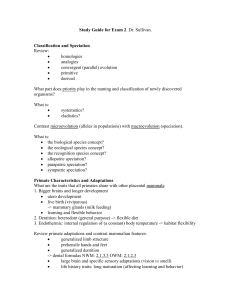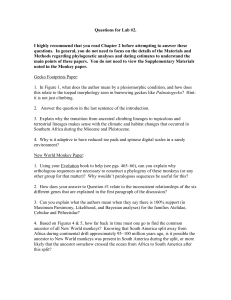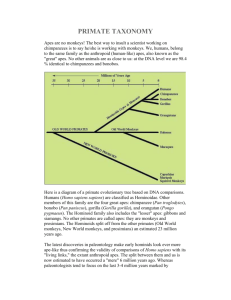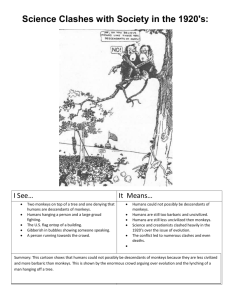Lab Manual Chapter 7
advertisement
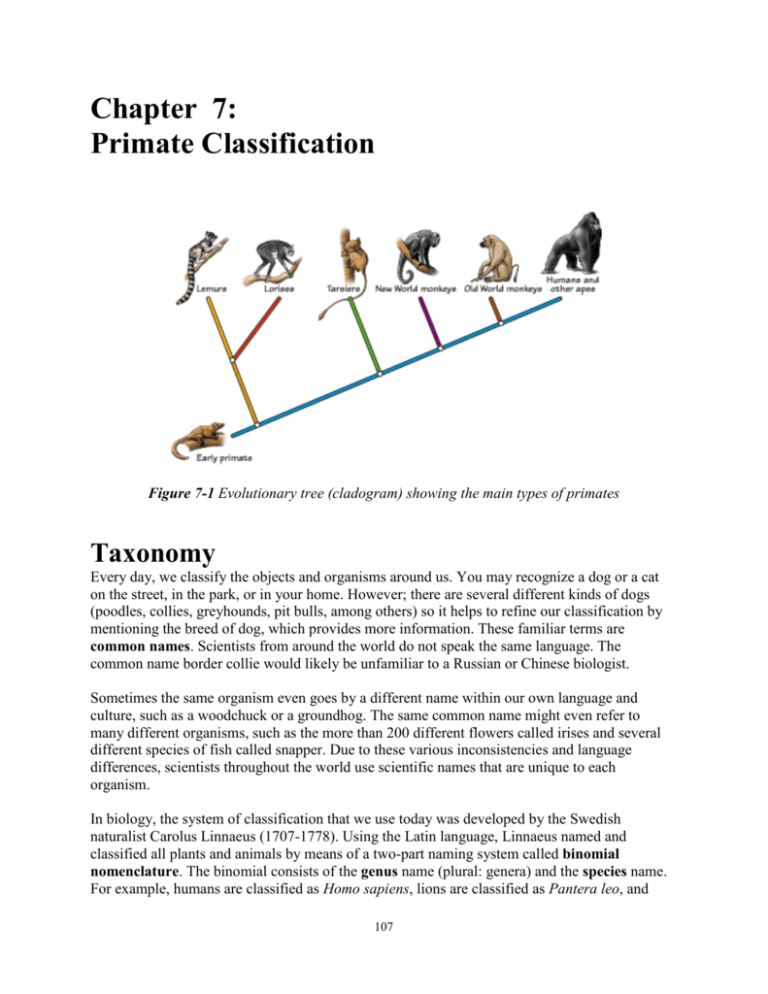
Chapter 7: Primate Classification Figure 7-1 Evolutionary tree (cladogram) showing the main types of primates Taxonomy Every day, we classify the objects and organisms around us. You may recognize a dog or a cat on the street, in the park, or in your home. However; there are several different kinds of dogs (poodles, collies, greyhounds, pit bulls, among others) so it helps to refine our classification by mentioning the breed of dog, which provides more information. These familiar terms are common names. Scientists from around the world do not speak the same language. The common name border collie would likely be unfamiliar to a Russian or Chinese biologist. Sometimes the same organism even goes by a different name within our own language and culture, such as a woodchuck or a groundhog. The same common name might even refer to many different organisms, such as the more than 200 different flowers called irises and several different species of fish called snapper. Due to these various inconsistencies and language differences, scientists throughout the world use scientific names that are unique to each organism. In biology, the system of classification that we use today was developed by the Swedish naturalist Carolus Linnaeus (1707-1778). Using the Latin language, Linnaeus named and classified all plants and animals by means of a two-part naming system called binomial nomenclature. The binomial consists of the genus name (plural: genera) and the species name. For example, humans are classified as Homo sapiens, lions are classified as Pantera leo, and 107 wolves are classified as Canis lupus. For proper notation, the genus name is always capitalized, the species name is not. Both terms should be italicized or underlined. The scientific name includes both the genus and the species names for an organism. Linnaeus also established a hierarchical system of classification above the genus and species levels. Groups at any level may be referred to as a taxon (plural: taxa). Using humans as an example, this system includes the following: Kingdom Phylum Class Order Family Genus Species Animalia Chordata Mammalia Primates Hominidae Homo sapiens These levels are further divided into other categories, such as suborders, superfamilies, and subfamilies. At each level, organisms are grouped by traits they have in common with each other due to shared ancestry. The more closely related two organisms are to each other, the more categories they will share. EXERCISE 1 Use a binomial system to classify the immediate members of your family (mother, father, siblings). Write their names in the spaces provided so that your system reflects the system used to designate species (e.g., your professor would be Johnson ilana, her brother would be Johnson david). _______________________________________________________________________ _______________________________________________________________________ _______________________________________________________________________ EXERCISE 2 If someone owns a large music collection composed of different styles of music, how might they classify and group their collection? _______________________________________________________________________ _______________________________________________________________________ _______________________________________________________________________ 108 Phylogeny and Cladistics Taxonomy is the science of classification and nomenclature, or categorizing and naming, respectively. Biologists and biological anthropologists prefer to use a system that groups organisms together on the basis of shared descent. Classification schemes that utilize phylogeny, a system that indicates the evolutionary relationships among the organisms under consideration, is considered superior to just grouping organisms because they look similar to one another. Some organisms may resemble one another because they share a common adaptation, such as sharks and dolphins, which share a streamlined body useful for maneuvering through the water, although they are not closely related (sharks are fish, and dolphins are mammals, separated by millions of years of evolution), or birds and butterflies, which both have wings used for adaptation to flying through the air (birds are vertebrates, butterflies are invertebrates). Figure 7-2 Analogous characters (wings) in four distantly related organisms In these examples, the body shape of the sharks and dolphins and the wings of butterflies and birds are analogous traits that are shared among organisms because they have a common adaptation, but not a recent common ancestor, and arise as a result of convergent evolution. Thus, these organisms may look similar, but they are not closely related. Analogous traits should be avoided when classifying organisms in a scientific context. Traits that should be used to classify organisms under a phylogenetic scheme are homologous traits that are shared by organisms because they have a recent common ancestor (that is, they inherited the traits from their ancestors). 109 Figure 7-3 Homologous characters (forelimbs) in mammals Scientists regularly argue over which traits or characters are the most important for classification. This has led to two schools of classification (Mayr, 1981): l. Cladistics is a method of classification which places organisms into evolutionary clades. A clade, or branch, consists of an ancestral organism and its descendents, nothing else. This form of classification is based on shared, derived (new) characteristics. Cladists discount change along a lineage and are interested primarily in branching events, or cladogenesis. 2. Evolutionary taxonomy places importance on change that may occur along a lineage over time. Evolutionary taxonomists believe that species change slowly over time through the process of anagenesis. Figure 7-4 The differences between Cladogenesis and Anagenesis 110 EXERCISE 3 Compare and contrast the following terms: a. homologous/analogous traits ____________________________________________________________________ ____________________________________________________________________ b. cladistics/evolutionary taxonomy ____________________________________________________________________ ____________________________________________________________________ EXERCISE 4 Review the organisms classified below. Which two organisms are the most closely related? Why? _______________________________________________________________________ _______________________________________________________________________ Order Suborder Superfamily Family Genus Species Organism 1 Primates Haplorhini Hominoidea Pongidae Pongo pygmaeus Organism 2 Primates Strepsirhini Lemuroidea Lemuridae Lemur catta Organism 3 Primates Haplorhini Hominoidea Pongidae Pan troglodytes Organism 4 Primates Haplorhini Cercopithecoidea Cercopithecidae Papio anubis EXERCISE 5 Review the organisms classified below. Which two organisms are the most closely related? Why? _______________________________________________________________________ _______________________________________________________________________ Order Suborder Superfamily Family Genus Species Organism 1 Primates Haplorhini Cercopithecoidea Cercopithecidae Papio cycocephalus Organism 2 Primates Strepsirhini Lemuroidea Lemuridae Lemur catta 111 Organism 3 Primates Haplorhini Hominoidea Pongidae Pan troglodytes Organism 4 Primates Haplorhini Cercopithecoidea Cercopithecidae Papio anubis Primate Taxonomy All primates are mammals. Numerous features link mammals as a class and separate them from other classes, such as the amphibians and reptiles. All mammals have numerous traits in common: Hair or fur Homeothemy (warm-blooded) Give birth to live young Lactation (breast-feeding) Diphyodont dentition (two sets of teeth: deciduous and permanent) Four-chambered heart with separation of oxygenated and deoxygenated blood Figure 7-5 Orders within the class Mammalia A species has been defined by biologist Ernst Mayr (1942, 1963) as a group of potentially interbreeding organisms in nature that are capable of having fertile offspring. About 250 species of primate are currently recognized. The smallest primate is the mouse lemur, weighing 2 ounces (40 g), while the largest primate is the male gorilla, which weighs up to 450 pounds (200 kg). Figure 7-6 Cladogram of the Primate order 112 Platyrrhin e Figure 7-7 Taxonomic chart of living primates. 113 Catarrhine The primates display an enormous range of diversity, not only in body size but also in diet, locomotion, coat color, habitat, and group social structure. However, all primates have grasping hands, large brains, and an emphasis on learned behavior. Primates can be separated from other mammals by a suite of traits that they share in common. The traits may be grouped into two clusters: (1) anatomical traits and (2) behavioral or life history traits. The anatomical traits shared by primates emphasize the importance of vision rather than the sense of smell, along with the excellent grasping ability seen in the hands and feet, which are traits that are essential for arboreality or tree-living, and include the following: Five digits on the hands and feet Prehensility (grasping ability) of the hands and feet with opposability (having a thumb or big toe that can touch the other four digits in the hand or foot, respectively) Nails, instead of claws Clavicles Emphasis on vision, including forward-facing eyes with binocular (overlapping) and stereoscopic (depth perception) vision Generalized dental pattern, including incisors, canines, premolars, and molars Reduction of the snout and sense of smell Enclosed eye orbits, which may be complete or partial (a postorbital bar) Primates mature and reproduce slowly, live long lives, and are strongly reliant on learned behavior rather than instinct. The behavioral traits, or life-history traits, shared by the primates emphasize these characters and include the following: Single offspring for most Extended juvenile periods where the child is dependent on the mother Large brains Dependence on learned behavior Strong Mother-infant bond Large group size where males live with females year-round EXERCISE 6 – STATION #1 Examine the casts in the laboratory comparing the anatomical traits of a nonprimate mammal to a primate skeleton. Fill in the following chart. Nonprimate Skeleton Grasping hands/feet? (Y/N) Opposable thumb? (Y/N) Nails or claws? Number of digits? Clavicle? (Y/N) Orbital closure? (Y/N) Reduced snout? (Y/N) 114 Primate Skeleton The primate order is divided into two suborders (Fleagle, 1998; Groves, 2001). Using a traditional scheme based on shared anatomical features, these suborders are the Prosimii (lemurs, lorises, and tarsiers) and the Anthropoidea (monkeys, apes, and humans). A more modern classification groups the taxa into the Strepsirhini (lemurs and lorises) and the Haplorhini (tarsiers, monkeys, apes, and humans). This scheme is based on fossil evidence that suggests that all monkeys and apes are descended from a tarsier-like ancestor that lived 55 mya. Figure 7-7 illustrates both taxonomic groupings. The main difference between the two classification schemes is how the tarsier is classified. Based on physical traits, some scientists prefer to classify them as Prosimians along with the lemurs and lorises. According to an evolutionary scheme, however, the tarsier is classified with the Haplorhines. Figure 7-8a From left to right: Ring-tailed lemur, Black and White Ruff lemur, Aye aye. The lemurs are found only on the island of Madagascar off the eastern coast of Africa and include such groups as the true lemurs, the dwarf lemurs, the indri and sifaka, and the aye-aye. The lemurs display a wide variety of diversity in diet, locomotion patterns, and social systems. Figure 7-8b A sifaka, the largest of the living lemurs. 115 The lorises live in tropical Africa and Asia and include animals such as the slow loris, slender loris, potto, and bush baby (or galago). All lorises and galagos are nocturnal and most are solitary. Figures 7-8 through 7-9 depict common strepsirhine (prosimian) primates. Figure 7-9 Left: A loris. Right: A galago (bush baby). All strepsirhines share the following features: Longer snout with whiskers and a wet nose (rhinarium), reliance on smell Triangular, high, and sharp-cusped molars Mandible that is unfused in the midline Large, mobile ears A grooming claw on the second digit of the foot in many taxa Scent glands Nocturnality common, with associated large eye orbits Dental comb for grooming in some, formed by the lower incisors and canines jutting forward Postorbital bar, partial orbital closure Figure 7-10 Strepsirhine skull showing a dental comb 116 EXERCISE 7 Examine Figures 7-8 through 7-9. Which two animals are nocturnal? How can you tell? _______________________________________________________________________ _______________________________________________________________________ _______________________________________________________________________ The Haplorhini are different from the Anthropoidea because of the inclusion of the tarsier in the former. The tarsier is a haplorhine but also a prosimian. It is closely related to the monkeys, apes, and humans and represents a link between the higher, and lower primates. Tarsiers are small primates that live on the islands of Southeast Asia. They are nocturnal and have the largest eye orbits relative to head size of any living mammal. They are named for their elongated tarsal (ankle) bones, which allow them to leap through the canopy. They are insectivorous and carnivorous and eat a variety of small vertebrates, such as lizards and bird eggs. Despite their size, locomotion, diet, and nocturnality, which links them to the strepsirhines, tarsiers do not have many of the anatomical traits described for the lemurs and lorises, such as a rhinarium or a postorbital bar (instead they exhibit a partial closure of the eye orbit), and they show differences in the placenta that are more similar to the higher primates, the anthropoids. Figure 7-11 illustrates the tarsier. Figure 7-11 Tarsier. 117 EXERCISE 8 What features link the tarsier to the lemurs and lorises, supporting the view that they should be grouped together as prosimians? _______________________________________________________________________ _______________________________________________________________________ _______________________________________________________________________ All Anthropoids (monkeys, apes, and humans) share the following traits: Generally larger body and brain size Reduced sense of smell, reduced snout, no rhinarium Diurnality, small eye orbits with complete orbital closure Square molar teeth with flatter cusps Fused mandible in the midline Small ears EXERCISE 9 – STATION #2 Examine the primate skeletons in the laboratory, comparing a strepsirhine to a haplorhine. Fill in the following chart to describe the differences. Strepsirhine Haplorhine Prehensile hands? (Y/N) Opposable thumbs? (Y/N) Grooming claw? (Y/N) Five digits? (Y/N) Clavicles? (Y/N) Orbital closure? (bar/complete) Size of orbits? (large/small) Snout length? (long/short) Tooth comb? (Y/N) Molar tooth cusps? (sharp/flat) Fused mandible? (Y/N) As illustrated in Figure 7-7, the Anthropoidea are divided into three superfamilies: the Ceboidea (New World monkeys), the Cercopithecoidea (Old World monkeys), and the Hominoidea (apes and humans). The Ceboidea include all the nonhuman primates in the Americas, all of which are monkeys and referred to as New World Monkeys. All ceboids are classified into the infraorder Platyrrhini, which indicates that their nose is broad and flat with widely spaced nostrils (platyrrhine nose). 118 Figure 7-12 Uakari (left), Spider Monkey (right). They live in Mexico and South America. All New World monkeys are arboreal; all are diurnal, but one, the exception being the aptly named owl monkey. New World monkeys are small, ranging from approximately 1 pound (< 1 kg) to 25 pounds (12 kg). All New World monkeys have three premolars, giving them a 2.1.3.3 dental formula. While all New World monkeys have tails, some also have prehensile tails. Researchers have classified the Ceboidea into two to four taxonomic families, including the capuchins, the sakis, the howler and spider monkeys, and the marmosets and tamarins. EXERCISE 10 a. Examine the illustrations of New World monkeys in Figure 7-12. Which monkey displays a prehensile tail? _______________________________________________________________________ b. How would you describe the shape of the nose visible in the uakari? _______________________________________________________________________ _______________________________________________________________________ c. How do the noses in the New World monkeys above compare to the noses seen in Figures 7-7 through 7-9, which depict strepsirhines? _______________________________________________________________________ _______________________________________________________________________ d. What do you notice about the location of the Spider Monkey in Figure 7-12? Is it found in the trees or on the ground? _______________________________________________________________________ _______________________________________________________________________ 119 The Cercopithecoidea includes all the Old World monkeys. All belong to the infraorder Catarrhini, indicating that the nose is narrow, with nostrils close together and pointing downward (catarrine nose). The Cercopithecoids live across the continents of Africa and Asia, in various habitats ranging from tropical forests and savannas, to snowy Japan. Some Old World monkeys spend considerable time on the ground, while others occupy arboreal habitats. All have two premolars in each quadrant of the mouth, for a dental formula of 2.1.2.3. The molars are called bilophodont because they have a unique design, where the cusps form two ridges for shearing leaves and other plant material. While the Old World monkeys have tails, their tails are never prehensile. They all exhibit ischial callosities, which are thickened calluses for sitting on their rump. Some species are sexually dimorphic, indicating that males are larger than females, especially in body size and canine size. The Old World monkeys are separated into two subfamilies, the Cercopithecinae and the Colobinae. The colobine monkeys have a semi-chambered stomach for breaking down the cellulo found in leaves. Colobine monkeys include the langurs and various groups called the leaf monkeys (or colobus monkeys). The cercopithecine monkeys include the macaques, baboons, guenons, mangabeys, and patas monkeys. Figure 7-13 illustrates some of the common Old World monkeys belonging to the colobine subfamily. Figure 7-14 illustrates some of the cercopithecine monkeys. Figure 7-13 Old World monkeys belonging to the subfamily Colobinae. From left to right: black and white colobus monkey, red colobus monkey, Hanuman langur. 120 Figure 7-14 Common Old World monkeys belonging to the subfamily Cercopithecinae. From left to right: Mandrill baboon, DeBrazza's monkey (a guenon), and the rare lion-tailed macaque. . EXERCISE 11 a. How do the Old World monkeys pictured in Figures 7-13 and 7-14 compare to the New World monkeys in terms of location? _______________________________________________________________________ _______________________________________________________________________ b. How would you describe the differences in the nose shape of the baboon and the uakari? _______________________________________________________________________ _______________________________________________________________________ EXERCISE 12 – STATION #3 Examine the pictures and/or skeletons in the lab. Fill in the following chart to compare New World monkeys to Old World monkeys. New World Monkey Nose shape/septum width Prehensile tail? (Y/N) Dental formula Arboreal/terrestrial? Diurnal/nocturnal? 121 Old World Monkey The final superfamily within the Anthropoidea is the Hominoidea, which includes apes and humans. Hominoids have much in common with the Cercopithecoids, including a catarrhine nose, a 2.1.2.3 dental formula, and sexual dimorphism. However, numerous traits distinguish the apes from the monkeys. In apes, the thorax is broad from side to side, not deep anteriorlyposteriorly as it is in monkeys. Apes do not have a tail, most ape species have a larger body size, and apes have long arms and shorter legs, indicating that all generally use some sort of suspensory (arm-hanging) locomotion. This group includes two ape families, the Hylobatidae (gibbons and siamangs) and the Pongidae (orangutans, gorillas, chimpanzees, and bonobos), and one human family, the Hominidae. The apes eat a variety of fruits and leaves and have different social structures (see Chapter 8). The gibbons and siamangs live in the tropical forests of south and southeast Asia and are called the "lesser apes" due to their smaller body size. The "great apes," or Pongids, have a much larger body size. Orangutans are the other Asian apes and are found exclusively in the tropical forests of the Indonesian islands of Borneo and Sumatra. Figure 7-15 Asian apes: white-faced gibbon (left), orangutan (right). The African apes consist of the gorillas, common chimpanzees, and the bonobos, which are close cousins to the chimpanzees. The gorillas are confined to the forests of west and central Africa, the chimpanzees live in diverse habitats across equatorial Africa, and the bonobo is restricted to rain forests of the Congo. 122 Figure 7-16 African apes. From left to right: gorilla, common chimpanzee, pygmy chimpanzee (bonobo). EXERCISE 13 a. How would you describe the shape of the nose in the pictures in Figure 7-16? _______________________________________________________________________ _______________________________________________________________________ b. How would you describe the difference in the shape of the thorax of the langur in Figure 7-13 and the gorilla in Figure 7-16. _______________________________________________________________________ _______________________________________________________________________ EXERCISE 14 Can you think of any traits that humans have that are not shared by the apes? _______________________________________________________________________ _______________________________________________________________________ _______________________________________________________________________ 123 EXERCISE 15 – STATION #4 Examine the skeletons or photos in your lab. Fill in the following chart to compare the catarrhines: the Old World monkeys, the apes, and humans. Old World Monkey Ape Human Lumbar region (long, short) Shape of rib cage (narrow, broad) Forelimb length (long, short) Finger length (long, short) Tail? (Y/N) Molar crown shape (Y-5, bilophodont) EXERCISE 16 Examine the primate photo shown here and answer the following questions. a. Is this primate a strepsirhine or a haplorhine? How can you tell? Can you determine any further information about this animal? ____________________________________________________________________ ____________________________________________________________________ ____________________________________________________________________ 124 b. Is this primate diurnal or nocturnal? How can you tell? ____________________________________________________________________ ____________________________________________________________________ EXERCISE 17 Examine the following primate photo and answer the following questions. a. Describe the nose shape of this primate. Based on this information, is this animal a platyrhine or a catarrhine? ____________________________________________________________________ ____________________________________________________________________ ____________________________________________________________________ b. Describe the shape of the thorax of this primate. Based on this information, what type primate is this? ____________________________________________________________________ ____________________________________________________________________ ____________________________________________________________________ 125 EXERCISE 18 Examine the following primate photo and answer the following questions. a. Is this animal diurnal or nocturnal? How can you tell? ____________________________________________________________________ ____________________________________________________________________ b. Describe the type of nose seen in this animal. Based on this information, can you determine what type of primate this is? ____________________________________________________________________ ____________________________________________________________________ ____________________________________________________________________ c. List two features visible in the photo that indicate that this animal is a primate. ____________________________________________________________________ ____________________________________________________________________ 126 EXERCISE 19 Match the traits on the left with the group they correspond most accurately (nonprimate mammal or primate) on the right. _____Claws _____Five digits _____Lack of opposability _____Excellent sense of smell _____Emphasis on vision _____Diphyodont dentition _____Clavicles _____Enclosed eye socket a. Nonprimate mammal trait b. Primate trait EXERCISE 20 Match the traits on the left to the group of primates that exhibit them on the right. _____Tooth comb _____Broad thorax _____Long snout _____Rhinarium _____Lack of a tail _____Prehensile tail _____Bilophodont molars _____Y-5 molars _____Catarrhine nose _____Platyrrhine nose _____Ischial callocities _____Nocturnality common a. Strepsirhine b. New World Monkey c. Old World Monkey d. Ape 127

